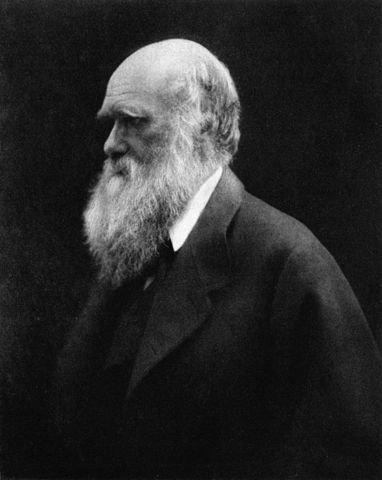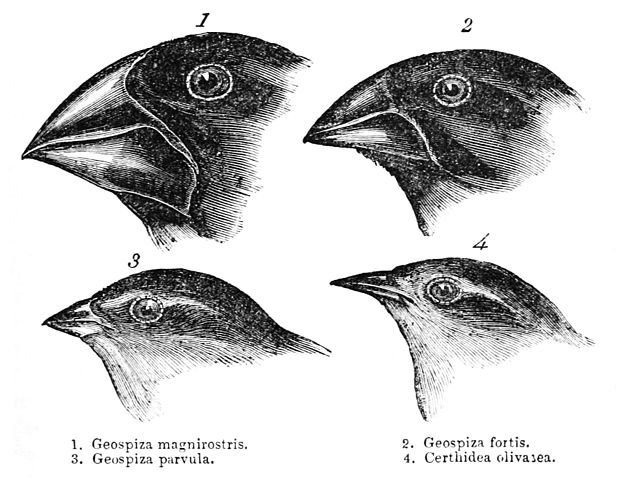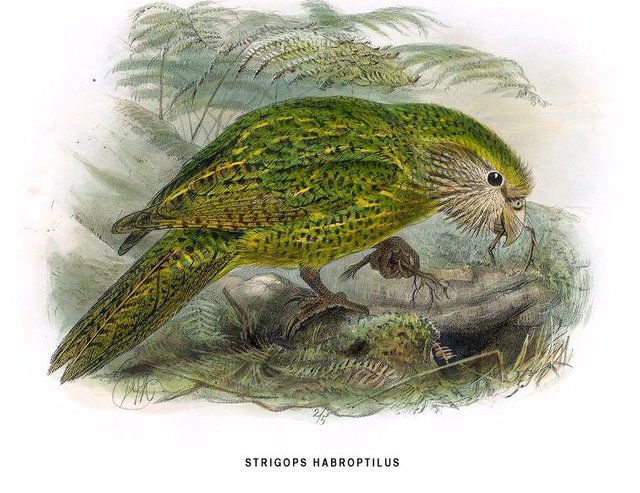EVOLUTION: The Doomed Mating of the Kakapo and The Theories on The Origin of Species.
On a few remote islands off the coast of New Zealand the world’s largest parrot – the kakapo – is just clinging to existence. Looking like a large green football with a beak, the kakapo was once an important part of New Zealand’s bird-rich ecosystem. Like many island birds that have evolved in an environment free from predators, the kakapo is flightless. It has also developed a few other odd characteristics.
Locals knew when it was the kakapo’s mating season because of its incredibly deep mating call: a sort of giant heartbeat in the night. The male kakapo sits on a hillside and emits a huge ‘whuumph’ from his vocal sacs. The problem is that, like all bass sounds, it is non-directional. This is a big drawback in a mating call because the females cannot tell where it is coming from.
All is well when numbers are high, but when kakapos are few and far between, the females cannot easily find the males. Like the dodo, the kakapo’s idyllic lifestyle came to an end after human settlers arrived with their animals; their numbers started to plummet. The Polynesian colonists (the Maoris) settled in New Zealand 1 000 years ago, bringing dogs and rats. These ate the eggs from the ground-level nests of the kakapo and other flightless birds. More recently, Europeans arrived, adding cats to the predators. Kakapos have not developed any new behaviour to deal with such enemies.
In 1999 there were 62 kakapos left, 26 females and 36 males. These are currently located on five off-shore islands where they have been relocated to protect them from introduced predatory mammals. All the birds have transmitters and their breeding activity is closely monitored: eggs are removed and carefully incubated. The breeding programme is showing signs of success, with some females being able to lay eggs twice a year. The kakapo may yet survive.
The last known surviving kakapo from the mainland is an aged male called Richard Henry who has been transported to an island for his own safety. It died in 2010 at the age of 80 years old. The New Zealand Department of Conservation is taking no chances with kakapo survival. All individuals are fitted with trackers and if a nesting female goes foraging, a worker will quickly put a thermal blanket over the eggs. 2001 was a record year for kakapo births. Presently, there are close to 200 kakapos left in New Zealand.
WHERE DO LIVING THINGS COME FROM?
To most human eyes, the living world seems fairly static. Like produces like: elephants give birth to baby elephants, frogs make frogs. It seems that no new species appear. There are literally millions of different species on Earth. Where did they come from?
THEORIES ON THE ORIGIN OF SPECIES
Ideas about the origins of species- including ourselves have been central themes in philosophical and religious thought for centuries., Until the nineteenth century, virtually everybody in the Christian world looked to the Bible. The book of Genesis provided the answers: all animals and plants were created at the same time, by the great Creator. Even the eminent taxonomist, Linnaeus, who in 1742 published his system for classifying all living plant species known at the time, said there are as many species as God created in the beginning’. Other religions had different versions of the same creationist idea.
The idea that species were not fixed, and that the infinite variety of living things had developed through a slow process of evolution, seems to have arisen first in early Greek philosophy and reappeared from time to time throughout the following centuries. It failed to gain lasting acceptance because no explanation could be found to show how the process might have come about. In addition, in some cultures, any ‘non-religious’ thought was strongly discouraged, even on penalty of death.
A catalyst in the development of the theory of evolution was the discovery of fossils. These were clearly the remains of extinct creatures. Why were they no longer alive?
One Christian explanation said that extinct species were the victims of a great global catastrophe, and that a new set of organisms had been created to replace them. It was even suggested that only the passengers aboard Noah’s Ark survived a great global flood. When it was pointed out that different rocks contained different types of plants and animals, it seemed that there would have had to be many such floods, and so the catastrophe theory gradually lost credibility.
An early attempt to explain the mechanism of evolution came from the French naturalist Lamarck, who had made extensive studies of different life forms. He was convinced of the process of evolution, but the mechanism he proposed in 1809 to explain it was wrong. Lamarck supposed that organisms adapt to their environment by developing new structures and losing old ones.
Such differences, acquired during the animal’s life, were then passed on to the next generation. As an example he cited the webbed feet of water birds. Lamarck suggested that, in an effort to swim, the birds extended their toes and so stretched the skin between them. The stretched condition was then inherited and this process was repeated until it produced a fully webbed foot.
With no knowledge of genes, chromosomes or DNA, this idea of the inheritance of acquired characteristics was perfectly reasonable for the time.
CHARLES DARWIN AND THE THEORY OF EVOLUTION
In a book with the shortened title Of The Origin of Species, Charles Darwin included these four ideas in his theory of evolution:
- The living world is changing, not static.
- The evolutionary process is usually gradual, not a series of jumps such as catastrophes and re-creations.
- The common ancestor theory. This suggested that closely related species evolved from one basic ancestor. Darwin said that man and apes evolved from a common ancestor, but the popular press took this to mean that humans had recently evolved from apes, leading to cartoons such as the one depicting man in the form of an ape.
- The theory of natural selection as a mechanism to explain evolution.
A working definition of evolution is ‘a change in the genetic composition of a population over time’. It has also been defined as ‘a gradual process in which new species develop from pre-existing ones’. But as we shall see in this article, populations can evolve without changing into new species.
The cornerstone of Darwin’s theory is that the mechanism of evolution is natural selection – this is known as Darwinism. The application of twentieth century knowledge about chromosomes, genes and DNA to Darwin’s theories is called neo-Darwinism.
Charles Darwin
Charles Darwin was the son of a doctor. After studying medicine in Edinburgh he changed his mind and prepared for a career in the Church. However, despite going to Cambridge to study theology (religion), Darwin retained his interest in biology and geology.
Darwin was offered the post of naturalist on the HMS Beagle, embarking on a scientific survey of South American waters. It was observations he made during this trip that first stimulated the young Darwin into contemplating the origins of species. As well as becoming convinced of the process of evolution, he also developed an idea about how it might happen. This trip was not only the turning point in Darwin’s life; it was also the start of the greatest ever revolution in our perception of the living world, and of our place within it.

On returning home, Darwin buried himself in his studies, determined to prove or disprove his ideas about the evolution of species. Like Lamarck, Darwin developed his theories with no knowledge of genes, chromosomes or DNA. Mendel’s work with peas was going on during Darwin’s lifetime but it remained hidden in an obscure journal.
Even though he managed to build up an overwhelming case for evolution, Darwin was reluctant to publish his theories, knowing the conflict they would cause with the Church. For more than 20 years Darwin carried on gathering evidence to support his theories. He was finally pushed into publication after exchanging letters with Alfred Russel Wallace: he too had come to the same conclusion about evolution. They agreed to make a joint announcement, and the Darwin-Wallace paper was presented to the Linnaean Society of London in July 1858.
In November 1859, Darwin published his revolutionary work, The Origin of Species by Means of Natural Selection. Few books before or since have caused quite such a controversy. Although Church leaders largely remained quiet, many people bitterly attacked it because it questioned the theory of creation. Darwin was called ‘the most dangerous man in England’.
So, how old is the Earth?
Accurately estimating the age of the Earth is central to the theory of evolution. In 1650, James Ussher (then the Archbishop Of Armagh) announced that his study of Hebrew literature had led him to the conclusion that the date of creation was the year 4004 BC. Dr. Lightfoot, vicar of the University church at Cambridge, took it a step further and proclaimed that the date of creation was 9 a.m. on 23 October, 4004 BC. Baron George Cuvier later stated that the Earth must be much older, more like 70 000 years.
Faced with the large array of different fossils, nineteenth century geologists decided that the Earth was much older still, in 1830, Charles Lyell suggested that the true age of the Earth would turn out to be millions, rather than thousands of years. He was the first to propose that old rocks could be uncovered or brought to the Earth’s surface (by volcanic activity, for example), so revealing the remains of long-dead species.
Ultra-sensitive dating techniques that measure the decay of radioactive isotopes have now put the age of the Earth at about 4 600 000 000 (4.6 billion) years. This is an important breakthrough because, although our brains cannot comprehend such a time scale, it fits in well with the idea of progressive evolution.
NATURAL SELECTION: ‘SURVIVAL OF THE FITTEST’
Darwin’s observations of the living world led him to three basic conclusions:
- Generally, organisms produce far more offspring than can possibly survive.
- Living things are locked in a struggle for survival. They compete for food, space, mates. Etc. In short, they are trying to eat and not be eaten, so that they can reproduce.
- Individuals of the same species are rarely identical: they show variation. There was nothing particularly original about these observations, or in the idea that organisms evolved. What Darwin did, however, was to put all these factors together and suggest natural selection as the mechanism for evolutionary change.
Natural selection is commonly simplified to ‘survival of the fittest’. Biologists define fitness as the ability of an organism to survive and reproduce. The fittest organisms survive to produce more offspring than less fit ones. In this way, the characteristic of a population can gradually change from generation to generation. Fitness in biology is a measure of reproductive success. So, a fit flowering plant produces and disperses more seeds than its competitors. Fit fungi are more successful because they produce more spores.

To illustrate the principle, imagine a population of blackbirds in a woodland. Like most organisms, they reproduce sexually and there is variation in the population. Some have better reflexes than others, forage for food more successfully, others have a better immune system. Normally, there is competition for resources such as food, mates and nesting sites. In this situation, the fittest birds survive and produce more offspring than others. The fitter birds may gather more food and so rear larger families than less fit individuals. Or they may rear two clutches of eggs in the time it takes others to produce one. The vital point here is that the fittest individuals pass their genes on to more of the next generation.
The severity of an organism’s circumstances is called the selection pressure. The greater the selection pressure, the faster the evolutionary process. When organisms have a short life cycle, the process can be very swift indeed. In the 1950s, farmers in the UK and Australia took the drastic step of introducing a deadly disease, myxomatosis. Into the ever-expanding rabbit population. This virus killed over 99 per cent of the rabbits: this is selection pressure at a massive level. Only the rabbits whose genes gave them resistance to myxomatosis were able to survive and pass on their genes to the next generation.
In my next post, I’ll discuss on natural selection in action and the different types of natural selection and evidence for evolution.
Thanks for reading.
REFERENCES
https://en.wikipedia.org/wiki/Kakapo
https://www.pbs.org/wnet/nature/blog/9027/
https://www.physicsoftheuniverse.com/topics_life.html
https://www.jstor.org/stable/24456814
https://en.wikipedia.org/wiki/Biogenesis
https://www.allaboutscience.org/origin-of-species.htm
https://www.smithsonianmag.com/science-nature/on-the-origin-of-a-theory-48941576/
https://en.wikipedia.org/wiki/Catastrophe_theory
https://www.britannica.com/science/inheritance-of-acquired-characteristics
https://en.wikipedia.org/wiki/Lamarckism
https://www.pbs.org/wgbh/evolution/educators/course/session2/explain_c_pop2.html
https://www.livescience.com/474-controversy-evolution-works.html
https://en.wikipedia.org/wiki/Darwinism

Questo post è stato condiviso e votato all'interno del discord del team curatori di discovery-it.
This post was shared and voted inside the discord by the curators team of discovery-it
Hello,
Your post has been manually curated by a @stem.curate curator.
We are dedicated to supporting great content, like yours on the STEMGeeks tribe.
If you like what we are doing, please show your support as well by following our Steem Auto curation trail.
Please join us on discord.
This post has been voted on by the SteemSTEM curation team and voting trail. It is elligible for support from @curie and @minnowbooster.
If you appreciate the work we are doing, then consider supporting our witness @stem.witness. Additional witness support to the curie witness would be appreciated as well.
For additional information please join us on the SteemSTEM discord and to get to know the rest of the community!
Thanks for having used the steemstem.io app and included @steemstem in the list of beneficiaries of this post. This granted you a stronger support from SteemSTEM.